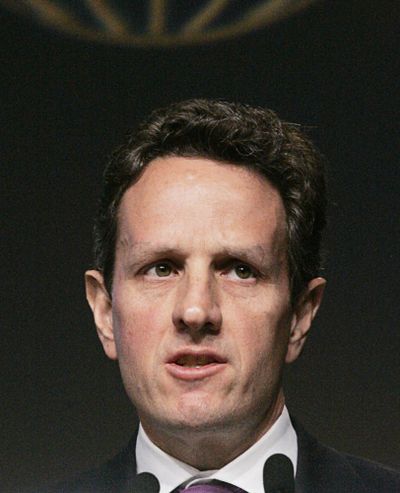Obama assembles economic team
N.Y. Fed president would run Treasury

WASHINGTON – President-elect Barack Obama has selected New York Federal Reserve Bank President Timothy Geithner as Treasury secretary, handing the post to a primary architect of the Bush administration’s response to the financial crisis, according to Democratic and industry officials Friday.
The stock markets cheered the would-be appointment of Geithner, who is well known to Wall Street. The Dow Jones industrial average had been down as much as 1.4 percent in the morning. Around 3 p.m., when news of Obama’s pick broke, the index shot up, ending the day 494.13, or 6.5 percent, higher.
At 47, Geithner is the same age as Obama and would represent a generational change in the highest levels of Washington economic policymaking, heading a remarkably young team of White House economic advisers tasked with sorting out one of the worst financial messes since the Great Depression.
A Democrat and a relative unknown outside the world of high finance, Geithner has worked closely with Treasury Secretary Henry M. Paulson Jr. to devise responses to the most critical events of the market turmoil, including the bailouts of the investment bank Bear Stearns and the insurance giant American International Group. Like Paulson, Geithner believes the Treasury should be given vast powers to develop experimental strategies for responding to the crisis and the flexibility to abandon them if they don’t work.
Geithner’s mentor is Lawrence Summers, 53, a Treasury secretary during the Clinton administration who also was in the running for the job. Summers instead will go to the White House and serve as a senior economic adviser to Obama, according to a senior Democratic official familiar with the matter. Meanwhile, Obama is seriously considering a former opponent in the primary campaign, New Mexico Gov. Bill Richardson, to head the Commerce Department, according to the official.
Joining Summers in the White House would be Jason Furman, 38, as a top economic adviser; Peter Orszag, 39, as White House budget director; and Austan Goolsbee, 39, on the president’s Council of Economic Advisers, sources familiar with the matter said.
The rollout of the economic team is expected to take place in Chicago on Monday, according to a transition source who spoke on condition of anonymity because the announcements have not been made yet. As for the timing, this source said, “Everything has been accelerated on the economic front because of the news of the last few months” but not in reaction to any specific market trends this week.
The problems facing the new administration are dire as the government’s effort to rescue the banking system falters. Friday, Goldman Sachs said it expected the economy to shrink even faster during the fourth quarter of this year, at a 5 percent annualized rate. The investment bank predicted that unemployment would soar to 9 percent by the end of next year.
Geithner has experience in addressing complex crises. In the late 1990s, he worked under Treasury Secretary Robert Rubin and Summers to guide the Clinton administration’s response to currency collapses in Russia, Mexico and Asia. In the last years of the administration, Summers became Treasury secretary and Geithner was promoted to undersecretary.
Geithner “will get a very favorable response in the Senate,” said Sen. Kent Conrad, D-N.D., chairman of the Senate Banking Committee. “You saw the relief rally in the market today. … These are the kind of people you want with their hand on the till in a storm. And we’re in a Category 4.”
Under Geithner, the Treasury would not be expected to alter its approach to the financial crisis – or how to spend the $700 billion in emergency rescue funding approved by Congress last month, though skepticism is building among lawmakers about whether Paulson has devised the right remedy to the problems.
Other than Paulson, no one had more say than Geithner in bailing out Bear Stearns in March or in the events leading up to the bankruptcy filing of the investment bank Lehman Brothers. He also was the primary architect of the $85 billion loan to rescue AIG, and then increased that amount to a total of $152 billion as the company’s woes continued. All of those actions have been criticized and debated by lawmakers and economists, who say the moves have contributed to the financial system’s turmoil.
With Orszag, Goolsbee and Furman, Obama is assembling a team in the White House of pragmatic centrists who believe in promoting free trade, reducing budget deficits, and using the tax code to narrow the widening gap between rich and poor. Unlike officials in the early Bush administration, they also believe in the power of government to enhance and guide market forces.
Orszag and Furman both served as directors of the Hamilton Project at the Brookings Institution, a research group founded by Rubin and others. Furman left that post earlier this year to join the Obama campaign as a senior economic adviser.